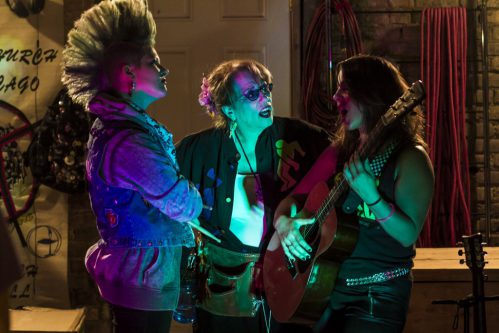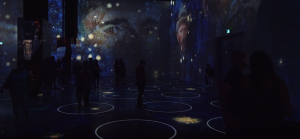Pictured above: The photo used for the first DIY theater and performance article I wrote, with Anna Rose Ii-Epstein, Jamie Newell, and Caroline Wright in Nothing Without a Company’s Punk Punk/Photo: Matthew Gregory Hollis
Introduction
On January 28, 2018, I put together a document to address the topic of DIY theater and performance. This was created out of two threads:
- My piece about DIY theater and performance in Chicago in Newcity Magazine, where I explored the definitions of this movement by gathering perspectives from non-mainstream, non-institutionalized theater groups and artists throughout the city.
- I was asked to join Scapi Magazine as Theater Editor, and wanted to establish what kind of coverage we would be focusing on.
Since then, that document served as a basis for the coverage of the DIY Theater section of Underground.
What It Is, What It Is Not
In order to understand what it is, I had to figure out what DIY theater was not:
- Extremely high ticket prices, extremely high ticket prices, even “accessible” ticket options are high
- Investor-owned
- Set and defined roles within the theater (1 producer, 1 director, 1 writer, etc.) with not collaboration
- A board or a large pool of investors are responsible not only for funding the initiative but are also stakeholders in the content the artists put out
- Investors have a say in artistic output
Theater artist, playwright, and director Jamie Olah had the suggestion to add “Big corporate (i.e. Fortune 500) sponsorship, or more colloquially speaking, externally or internally owned sources” as what DIY theater is not.
I originally had the following two points on what DIY theater is not, but realized they were qualities that would be difficult to uphold for DIY theater groups and artists:
- For-profit business whose proceeds do not go back entirely to workers/artists
- Income for a space/company/group is coming from someone who’s giving it to them and is looking to make a profit
After narrowing down what DIY theater is not, I was able to determine what it is:
- Collaborative in nature (roles and productions)
- Testing conventional limits of performance
- Groups/collectives/etc. are owned by workers/artists
- Portion of the profits do go to paying artists and workers
- Experimental and subversive themes often happening
- Performance options that are accessible to folks of different backgrounds
Originally, I had the following two points on what DIY theater is but opted to remove them:
- If the business is for profit, surplus goes back to the workers/artists
- No investor owned groups
The “definition” of DIY theater and performance that was developed through my own coverage and through the growth of my section at Scapi was constantly changing and developing as we figured out what the term meant. We knew it would be hard to cover groups where the profits of the production exclusively went to the artists. What seemed more important, in the end, was that a portion of the profits went to paying artists and workers.
We got feedback on how the word “profits” could trip people up. It often did not make sense when we described a non-profit business model. One thing Editor in Chief of Scapi Magazine Daniel Johanson pointed out: “It is important to think about if the income for a space/company/group is coming from someone who’s giving it to them and is looking to make a profit.”
We also thought about what it meant to have “no investors,” which is, again, a hard rule to follow to keep a production or team going.
Questions
Constantly exploring the definitions of DIY theater and performance meant asking theater artists their perspectives on the movement. Below are some of the questions that were peppered into interviews, news, features, and more:
- What are some additional articles written by journalists that explore the ideas behind DIY theater and performance?
- Where does it intersect or correlate with the DIY music scene?
- What does DIY mean in terms of theater and performance? How do you define it? What does it look like?
- What are the goals of DIY theater/performance? What makes it inherently different than mainstream/storefront theater?
- Is it possible for a theater to be a storefront/have a permanent location and also be DIY?
- How are audiences treated differently in DIY theater/performance spaces?
- How are artists/creators treated differently in DIY theater/performance spaces?
- What does the future of DIY theater/performance look like?
- Is it possible for a theater/space to go from being DIY to being mainstream? What does that look like? Where and when does that transition happen?
Audience Reach Thoughts
Others’ articles and voices contributed to the makings of the term. Without their perspectives, the living and breathing definitions could not exist:
- Monty Cole’s manifesto on Rescripted in response to Pass Over, performed at Steppenwolf Theatre: This insightful piece examined the same people who read mainstream theater critics and are those who attend mainstream shows. The demographic: white, middle-to-upper-class folks, typically middle-aged or older.
- Mainstream theaters hike up their ticket prices, serve certain audiences (aforementioned) and appeal to that audience and thus their subscriber platforms. They’re also located in neighborhoods and places that are only available to those demographics.
- DIY theaters, social-justice oriented theaters, and DIY performance artists are serving audiences outside of this mainstream reach. They make theater affordable. They position themselves in neighborhoods where demographics are other than white/middle-to-upper-class. These companies were born with the ability to be communicated via word of mouth, via the internet, which could never have happened before 1990. They’re able to promote and support themselves in communities with the opportunity of having free/affordable platforms to promote themselves on. I interviewed theater companies and artists like Free Street Theater, Katrina Dion, Coya Paz, Ricardo Gamboa, Quenna Barrett, FEMelanin, Mariana Green, Deanalís Resto, For Youth Inquiry (FYI), Collaboraction Theatre Company, and Marcus Robinson in this Newcity Magazine piece to learn more about these initiatives.
Associated Words
Words are obviously crucial to me as a writer, and finding similar, related, and inspired words to surround the term “DIY” was important to me. Here’s some of the ones I came up with as being directly related to DIY theater and performance:
- Anti past establishment
- Opposite of represented
- Delineated
- Describe or portray (something) precisely.
- Synonyms: describe, set forth/out, present, outline, sketch, depict, represent;
- Indicate the exact position of (a border or boundary).
- Synonyms: outline, trace, block in, mark (out/off), delimit
- Describe or portray (something) precisely.
- Non-mainstream
- Niche
- Off the beaten path
- Accessible
- Non-institutionalized
I also thought about how these words related or did not relate:
- Abnormal
- Eccentric
- Exceptional
- Extraordinary
- Infrequent
- Irregular
- Esecondary
- Uncommon
- Unusual
- Auxiliary
Ultimately, all these ideas, specific and abstract, allowed me to fulfill Scapi’s motto was and continues to be: cover the under-served perspectives of Chicago.
In Sum
We knew that there would be groups and artists that fell into our coverage that were “DIY-ish”, as we acknowledged it as impossible for theater artists to fit strictly into the confines of DIY as they work through in the American theater model, i.e. through capitalist systems.
What we placed as the highest stipulation in the Underground section was focusing on highlighting the voices of LGBTQIA+, PoC, womxn+, immigrant populations, and disenfranchised folks, in general.
There are so many wonderful journalists and publications doing the good work to highlight the underserved perspectives. I look forward to witnessing in, participating in, and writing about the evolution of Chicago’s theater scene, from DIY to mainstream.











Be First to Comment